Towards Digital Twins of the Oceans: The Potential of Machine Learning for Monitoring the Impacts of Offshore Wind Farms on Marine Environments
Abstract
:1. Introduction
2. Materials and Methods
2.1. Study Site and Data
2.2. Workflow
3. Results and Discussion
3.1. Missing Value Imputation
3.2. Anomaly Detection
3.3. Explainability
4. Conclusions
Author Contributions
Funding
Institutional Review Board Statement
Informed Consent Statement
Data Availability Statement
Acknowledgments
Conflicts of Interest
Abbreviations
| AI | Artificial Intelligence |
| CHL | Chlorophyll |
| COPOD | Copula-Based Outlier Detection |
| DTWkNN | Dynamic Time Warping k-Nearest Neighbor |
| IForest | Isolation Forest |
| LOF | Local Outlier Factor |
| OCSVM | One-Class Support Vector Machine |
| OLCI | Ocean and Land Color Instrument |
| OWF | Offshore Wind Farm |
| SLSTR | Sea and Land Surface Temperature Radiometer |
| SSS | Sea Surface Salinity |
| SST | Sea Surface Temperature |
| TSM | Total Suspended Matter |
References
- Wind Europe. Offshore Wind in Europe—Key Trends and Statistics 2020; Technical Report; Wind Europe: Brussels, Belgium, 2021. [Google Scholar]
- The European Green Deal. Communication from the Commission to the European Parliament, the European Council, the Council, the European Economic and Social Committee and the Committee of the Regions (COM(2019) 640 Final). 2019. Available online: https://eur-lex.europa.eu/legal-content/EN/TXT/?uri=CELEX:52019DC0640 (accessed on 16 February 2023).
- Akhtar, N.; Geyer, B.; Schrum, C. Impacts of Accelerating Deployment of Offshore Windfarms on Near-Surface Climate. Sci. Rep. 2022, 12, 18307. [Google Scholar] [CrossRef] [PubMed]
- Galparsoro, I.; Menchaca, I.; Seeger, I.; Nurmi, M.; McDonald, H.; Garmendia, J.M.; Pouso, S. Mapping Potential Environmental Impacts of Offshore Renewable Energy. ETC/ICM Report 2/2022, European Topic Centre on Inland, Coastal and Marine Waters. 2022. Available online: https://www.eionet.europa.eu/etcs/etc-icm/products/etc-icm-reports/etc-icm-report-2-2022-mapping-potential-environmental-impacts-of-offshore-renewable-energy (accessed on 16 February 2023).
- Broström, G. On the Influence of Large Wind Farms on the Upper Ocean Circulation. J. Mar. Syst. 2008, 74, 585–591. [Google Scholar] [CrossRef]
- Floeter, J.; Pohlmann, T.; Harmer, A.; Möllmann, C. Chasing the Offshore Wind Farm Wind-Wake-Induced Upwelling/Downwelling Dipole. Front. Mar. Sci. 2022, 9, 884943. [Google Scholar] [CrossRef]
- Floeter, J.; van Beusekom, J.E.; Auch, D.; Callies, U.; Carpenter, J.; Dudeck, T.; Eberle, S.; Eckhardt, A.; Gloe, D.; Hänselmann, K.; et al. Pelagic Effects of Offshore Wind Farm Foundations in the Stratified North Sea. Prog. Oceanogr. 2017, 156, 154–173. [Google Scholar] [CrossRef]
- Daewel, U.; Akhtar, N.; Christiansen, N.; Schrum, C. Offshore Wind Farms Are Projected to Impact Primary Production and Bottom Water Deoxygenation in the North Sea. Commun. Earth Environ. 2022, 3, 292. [Google Scholar] [CrossRef]
- Schultze, L.K.P.; Merckelbach, L.M.; Horstmann, J.; Raasch, S.; Carpenter, J.R. Increased Mixing and Turbulence in the Wake of Offshore Wind Farm Foundations. J. Geophys. Res. Ocean. 2020, 125, e2019JC015858. [Google Scholar] [CrossRef]
- Carpenter, J.R.; Merckelbach, L.; Callies, U.; Clark, S.; Gaslikova, L.; Baschek, B. Potential Impacts of Offshore Wind Farms on North Sea Stratification. PLoS ONE 2016, 11, e0160830. [Google Scholar] [CrossRef]
- Grieves, M.; Vickers, J. Digital Twin: Mitigating Unpredictable, Undesirable Emergent Behavior in Complex Systems. In Transdisciplinary Perspectives on Complex Systems; Springer: Cham, Switzerland, 2016; pp. 85–113. [Google Scholar] [CrossRef]
- Fuller, A.; Fan, Z.; Day, C.; Barlow, C. Digital Twin: Enabling Technologies, Challenges and Open Research. IEEE Access 2020, 8, 108952–108971. [Google Scholar] [CrossRef]
- Nativi, S.; Mazzetti, P.; Craglia, M. Digital Ecosystems for Developing Digital Twins of the Earth: The Destination Earth Case. Remote Sens. 2021, 13, 2119. [Google Scholar] [CrossRef]
- Hassani, H.; Huang, X.; MacFeely, S. Enabling Digital Twins to Support the UN SDGs. Big Data Cogn. Comput. 2022, 6, 115. [Google Scholar] [CrossRef]
- Blair, G.S. Digital Twins of the Natural Environment. Patterns 2021, 2, 100359. [Google Scholar] [CrossRef] [PubMed]
- Wind Europe. Our Energy, Our Future How Offshore Wind Will Help Europe Go Carbon-Neutral; Technical Report; Wind Europe: Brussels, Belgium, 2019. [Google Scholar]
- Doerffer, R. OLCI Level 2 Algorithm Theoretical Basis Document Ocean Colour Turbid Water. 2010. Available online: https://www.eumetsat.int/media/38636 (accessed on 16 February 2023).
- Brüning, T.; Li, X.; Schwichtenberg, F.; Lorkowski, I. An Operational, Assimilative Model System for Hydrodynamic and Biogeochemical Applications for German Coastal Waters. Hydrogr. Nachrichten 2021, 118, 6–15. [Google Scholar] [CrossRef]
- Paradilaga, S.; Sulistyoningsih, M.; Lestari, R.K.; Laksitaningtyas, A. Flood Prediction Using Inverse Distance Weighted Interpolation of K-Nearest Neighbor Points. In Proceedings of the 2021 IEEE International Geoscience and Remote Sensing Symposium IGARSS, Brussels, Belgium, 11–16 July 2021; pp. 4616–4619. [Google Scholar] [CrossRef]
- Chandola, V.; Banerjee, A.; Kumar, V. Anomaly Detection: A Survey. ACM Comput. Surv. 2009, 41, 15:1–15:58. [Google Scholar] [CrossRef]
- Oehmcke, S.; Zielinski, O.; Kramer, O. kNN Ensembles with Penalized DTW for Multivariate Time Series Imputation. In Proceedings of the 2016 International Joint Conference on Neural Networks (IJCNN), Vancouver, BC, Canada, 24–29 July 2016; pp. 2774–2781. [Google Scholar] [CrossRef]
- Zhao, Y.; Nasrullah, Z.; Li, Z. PyOD: A Python Toolbox for Scalable Outlier Detection. J. Mach. Learn. Res. 2019, 20, 1–7. [Google Scholar]
- Breunig, M.; Kröger, P.; Ng, R.; Sander, J. LOF: Identifying Density-Based Local Outliers. In Proceedings of the 2000 ACM SIGMOD International Conference on Management of Data, Dallas, TX, USA, 15–18 May 2000. [Google Scholar] [CrossRef]
- Liu, F.T.; Ting, K.M.; Zhou, Z.H. Isolation Forest. In Proceedings of the 2008 Eighth IEEE International Conference on Data Mining, Pisa, Italy, 15–19 December 2008; pp. 413–422. [Google Scholar] [CrossRef]
- Schölkopf, B.; Williamson, R.C.; Smola, A.; Shawe-Taylor, J.; Platt, J. Support Vector Method for Novelty Detection. In Proceedings of the Annual Conference on Neural Information Processing Systems, Denver, CO, USA, 29 November–4 December 1999; Solla, S., Leen, T., Müller, K., Eds.; MIT Press: Cambridge, MA, USA, 1999; Volume 12. [Google Scholar]
- Li, Z.; Zhao, Y.; Botta, N.; Ionescu, C.; Hu, X. COPOD: Copula-Based Outlier Detection. In Proceedings of the 2020 IEEE International Conference on Data Mining (ICDM), Sorrento, Italy, 17–20 November 2020; pp. 1118–1123. [Google Scholar] [CrossRef]
- Han, S.; Hu, X.; Huang, H.; Jiang, M.; Zhao, Y. ADBench: Anomaly Detection Benchmark. arXiv 2022, arXiv:2206.09426. [Google Scholar] [CrossRef]
- Goldstein, M.; Uchida, S. A Comparative Evaluation of Unsupervised Anomaly Detection Algorithms for Multivariate Data. PLoS ONE 2016, 11, e0152173. [Google Scholar] [CrossRef]
- Agarwal, A.; Gupta, N. Comparison of Outlier Detection Techniques for Structured Data. arXiv 2021, arXiv:2106.08779. [Google Scholar]
- Paskyabi, M.B.; Fer, I. Upper Ocean Response to Large Wind Farm Effect in the Presence of Surface Gravity Waves. Energy Procedia 2012, 24, 245–254. [Google Scholar] [CrossRef]
- Gevaert, C.M. Explainable AI for Earth Observation: A Review Including Societal and Regulatory Perspectives. Int. J. Appl. Earth Obs. Geoinf. 2022, 112, 102869. [Google Scholar] [CrossRef]
- El-Mihoub, T.A.; Nolle, L.; Stahl, F. Explainable Boosting Machines for Network Intrusion Detection with Features Reduction. In Proceedings of the Artificial Intelligence XXXIX: 2022 42nd SGAI International Conference on Artificial Intelligence, Cambridge, UK, 13–15 December 2022; Bramer, M., Stahl, F., Eds.; Lecture Notes in Computer Science. Springer: Cham, Switzerland, 2022; pp. 280–294. [Google Scholar] [CrossRef]
- Bauer, P.; Stevens, B.; Hazeleger, W. A Digital Twin of Earth for the Green Transition. Nat. Clim. Chang. 2021, 11, 80–83. [Google Scholar] [CrossRef]
- Benedetti, P.; Ienco, D.; Gaetano, R.; Ose, K.; Pensa, R.G.; Dupuy, S. M3 Fusion: A Deep Learning Architecture for Multiscale Multimodal Multitemporal Satellite Data Fusion. IEEE J. Sel. Top. Appl. Earth Obs. Remote Sens. 2018, 11, 4939–4949. [Google Scholar] [CrossRef]
- Jung, S.; Yoo, C.; Im, J. High-Resolution Seamless Daily Sea Surface Temperature Based on Satellite Data Fusion and Machine Learning over Kuroshio Extension. Remote Sens. 2022, 14, 575. [Google Scholar] [CrossRef]
- Irrgang, C.; Boers, N.; Sonnewald, M.; Barnes, E.A.; Kadow, C.; Staneva, J.; Saynisch-Wagner, J. Towards Neural Earth System Modelling by Integrating Artificial Intelligence in Earth System Science. Nat. Mach. Intell. 2021, 3, 667–674. [Google Scholar] [CrossRef]
- VanDerHorn, E.; Mahadevan, S. Digital Twin: Generalization, Characterization and Implementation. Decis. Support Syst. 2021, 145, 113524. [Google Scholar] [CrossRef]
- Karadayı, Y.; Aydin, M.N.; Öğrenci, A.S. A Hybrid Deep Learning Framework for Unsupervised Anomaly Detection in Multivariate Spatio-Temporal Data. Appl. Sci. 2020, 10, 5191. [Google Scholar] [CrossRef]
- Fisher, W.D.; Camp, T.K.; Krzhizhanovskaya, V.V. Anomaly Detection in Earth Dam and Levee Passive Seismic Data Using Support Vector Machines and Automatic Feature Selection. J. Comput. Sci. 2017, 20, 143–153. [Google Scholar] [CrossRef]
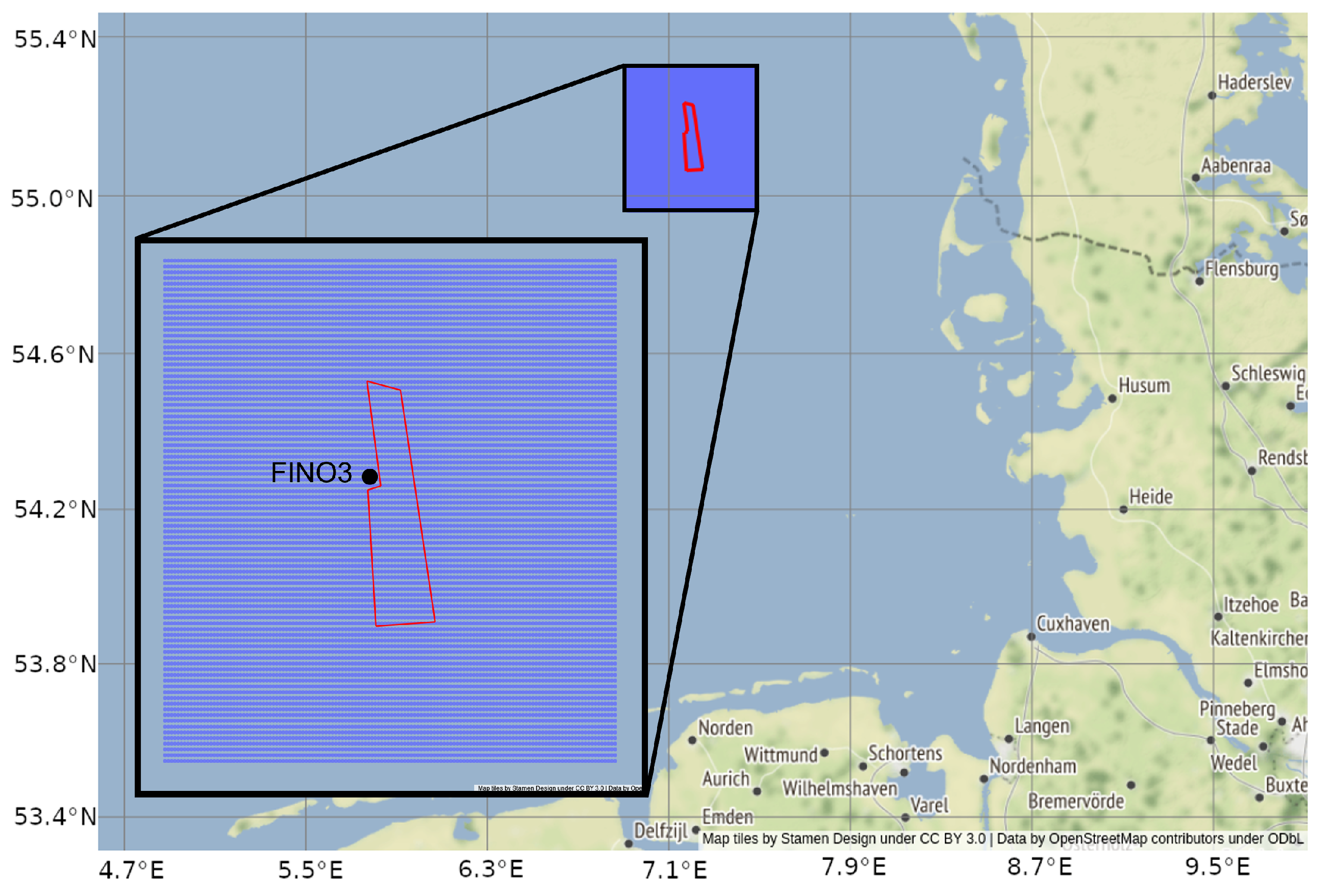

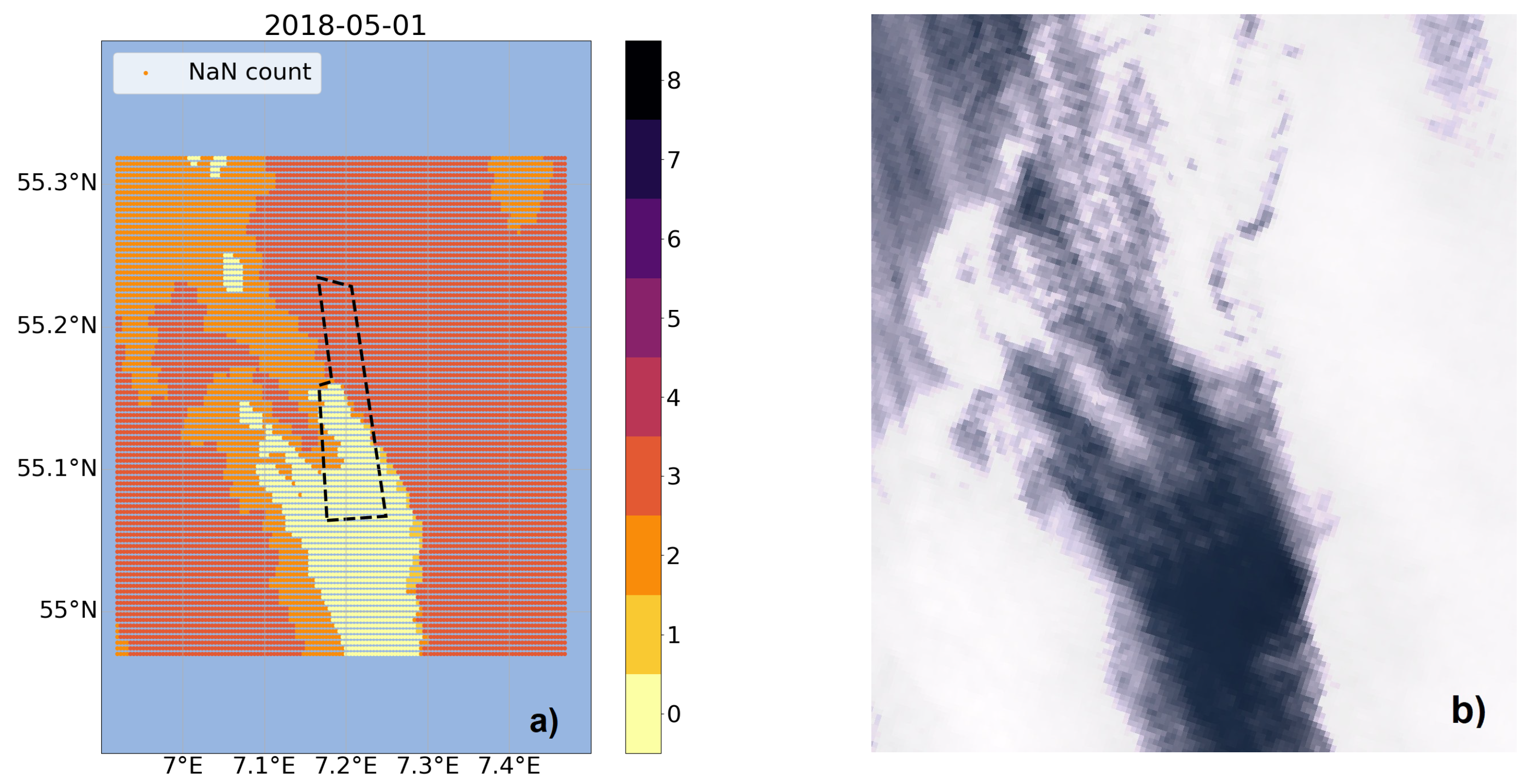
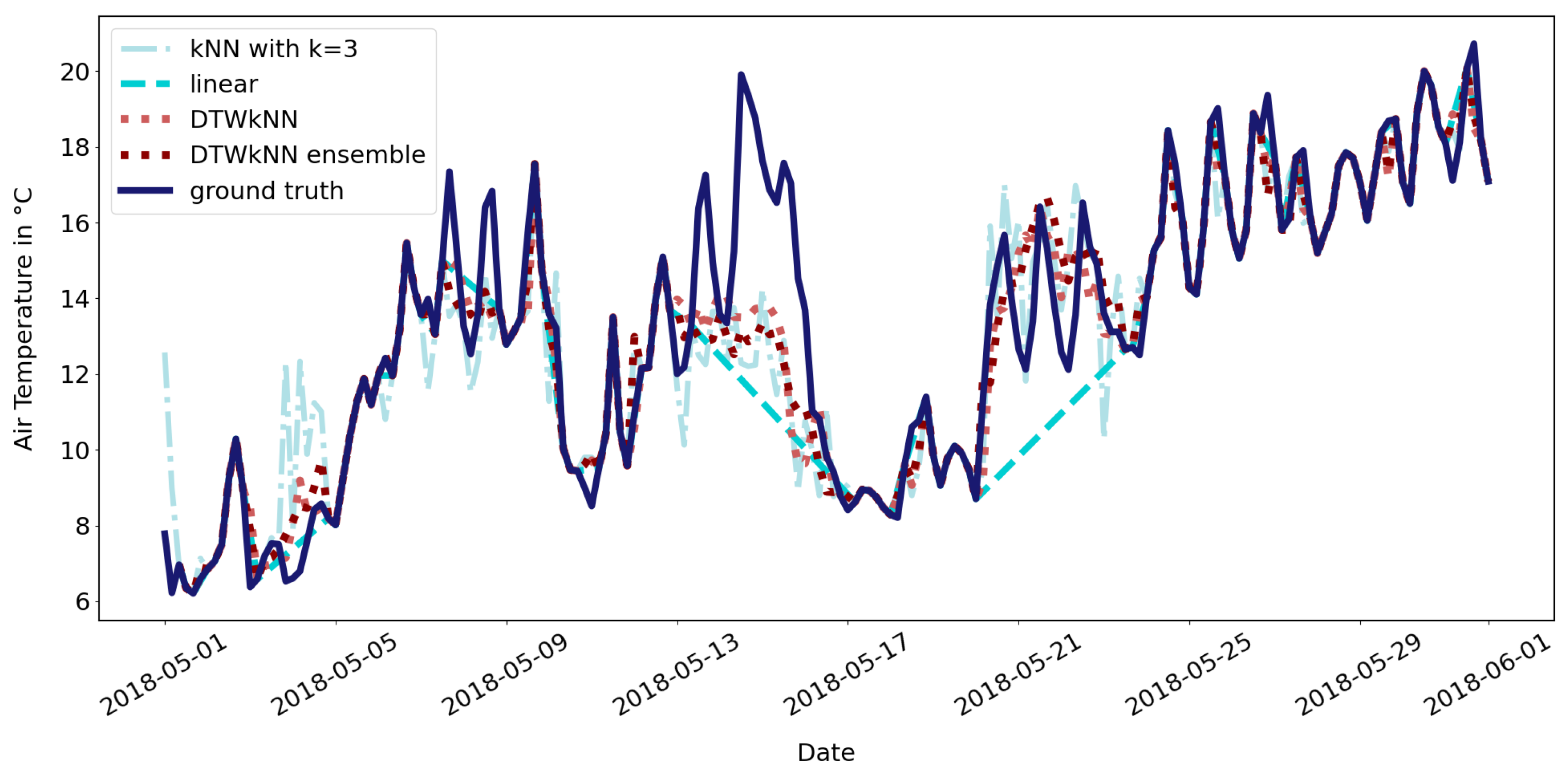
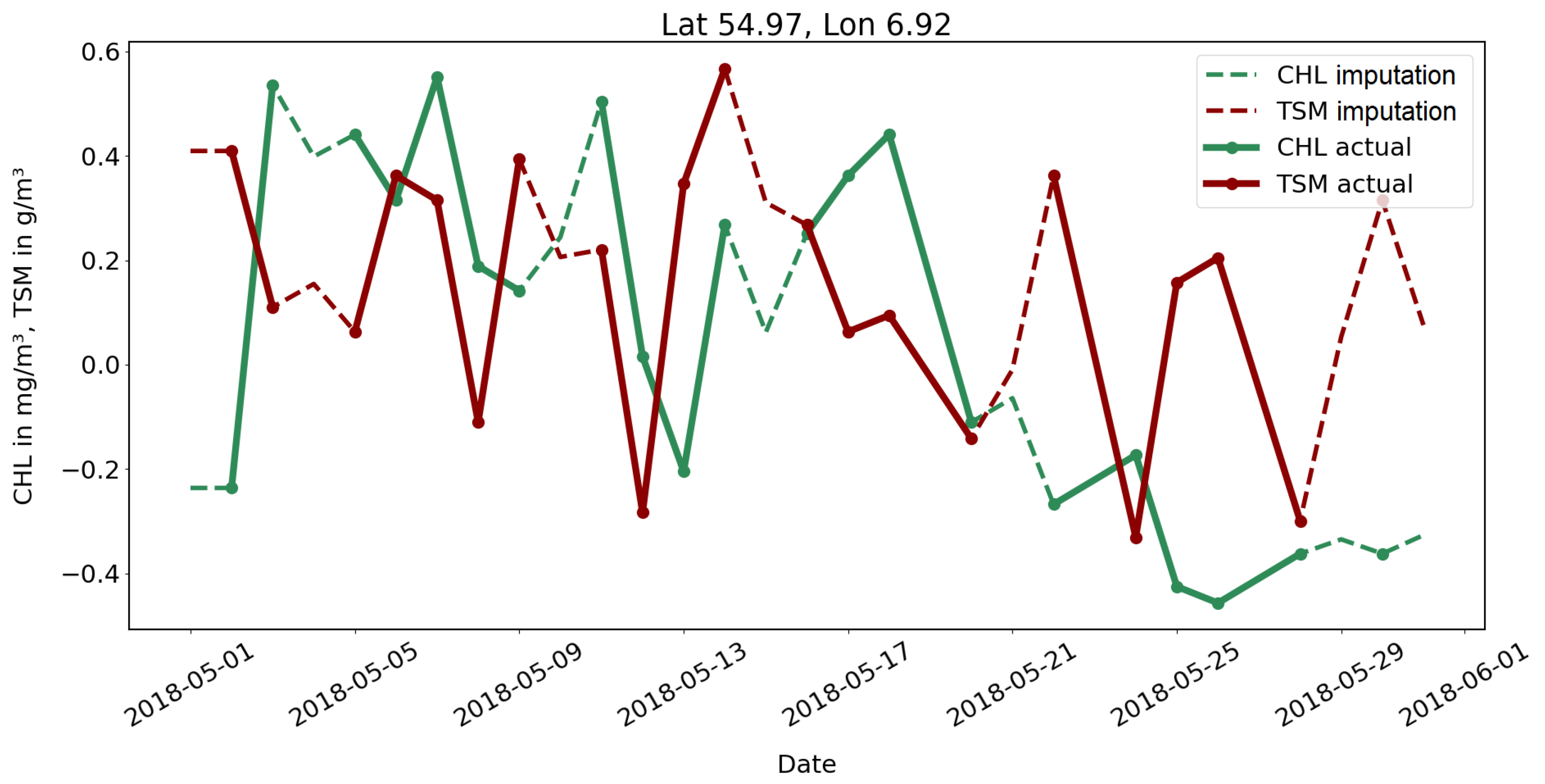
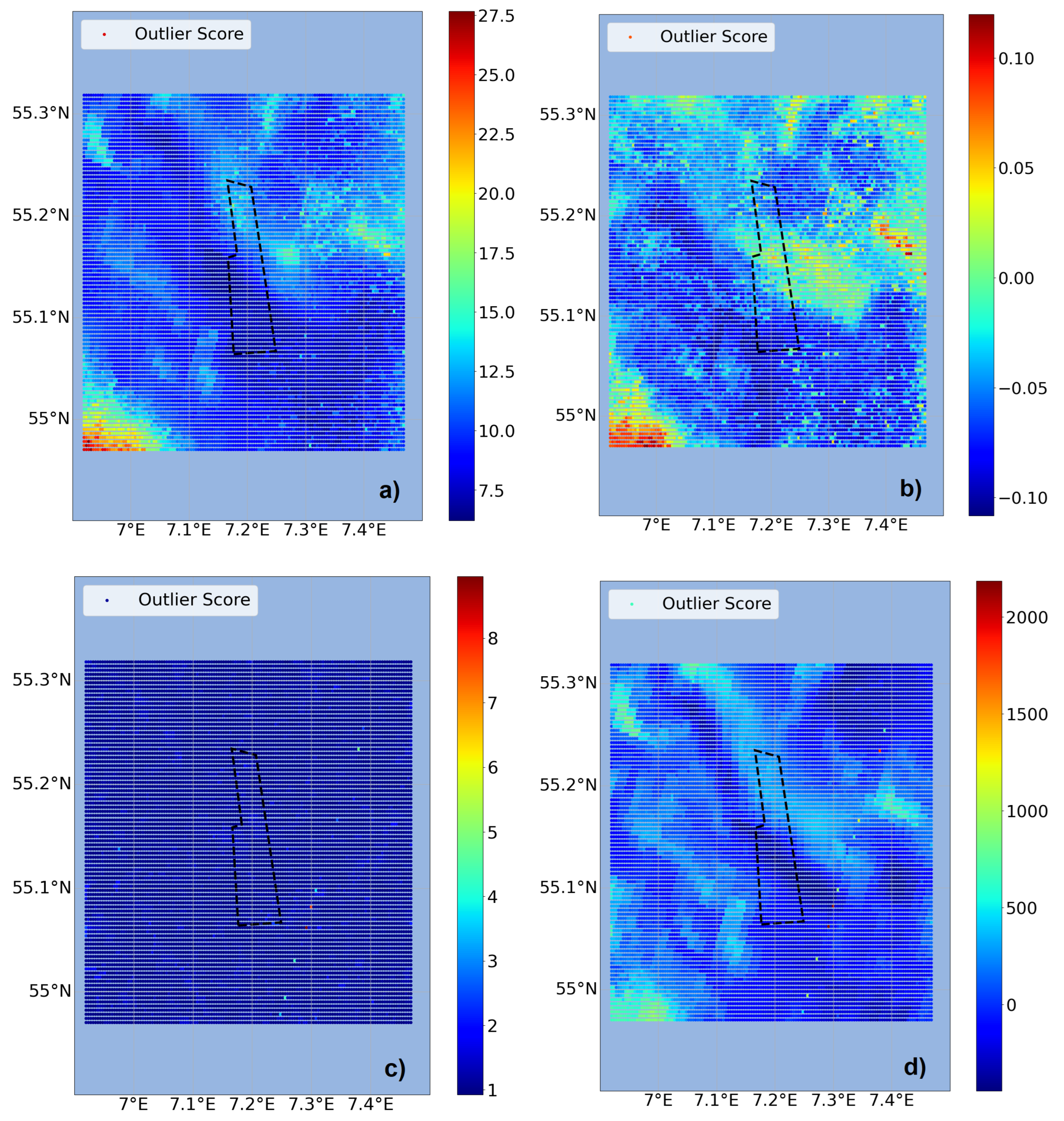
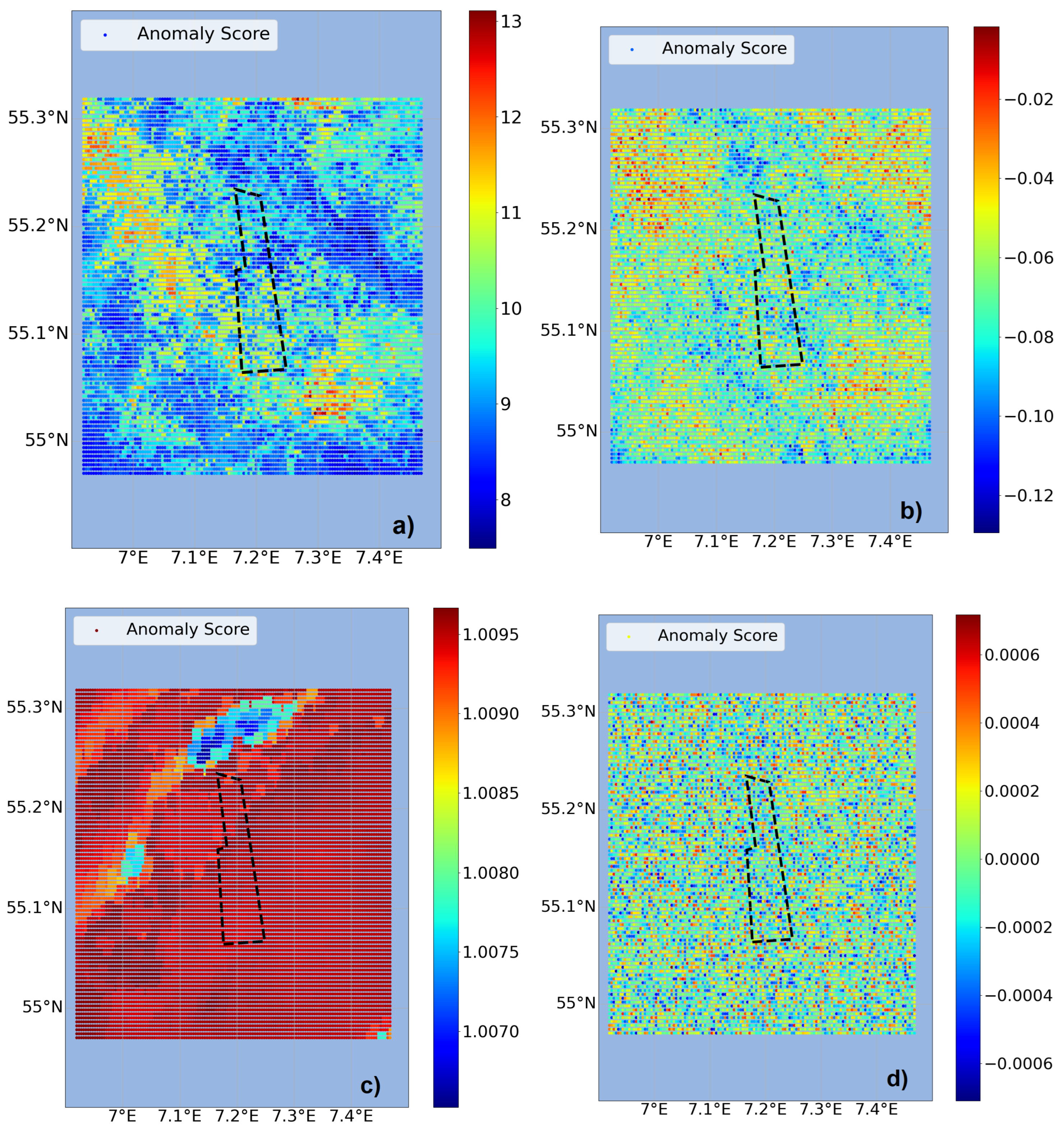

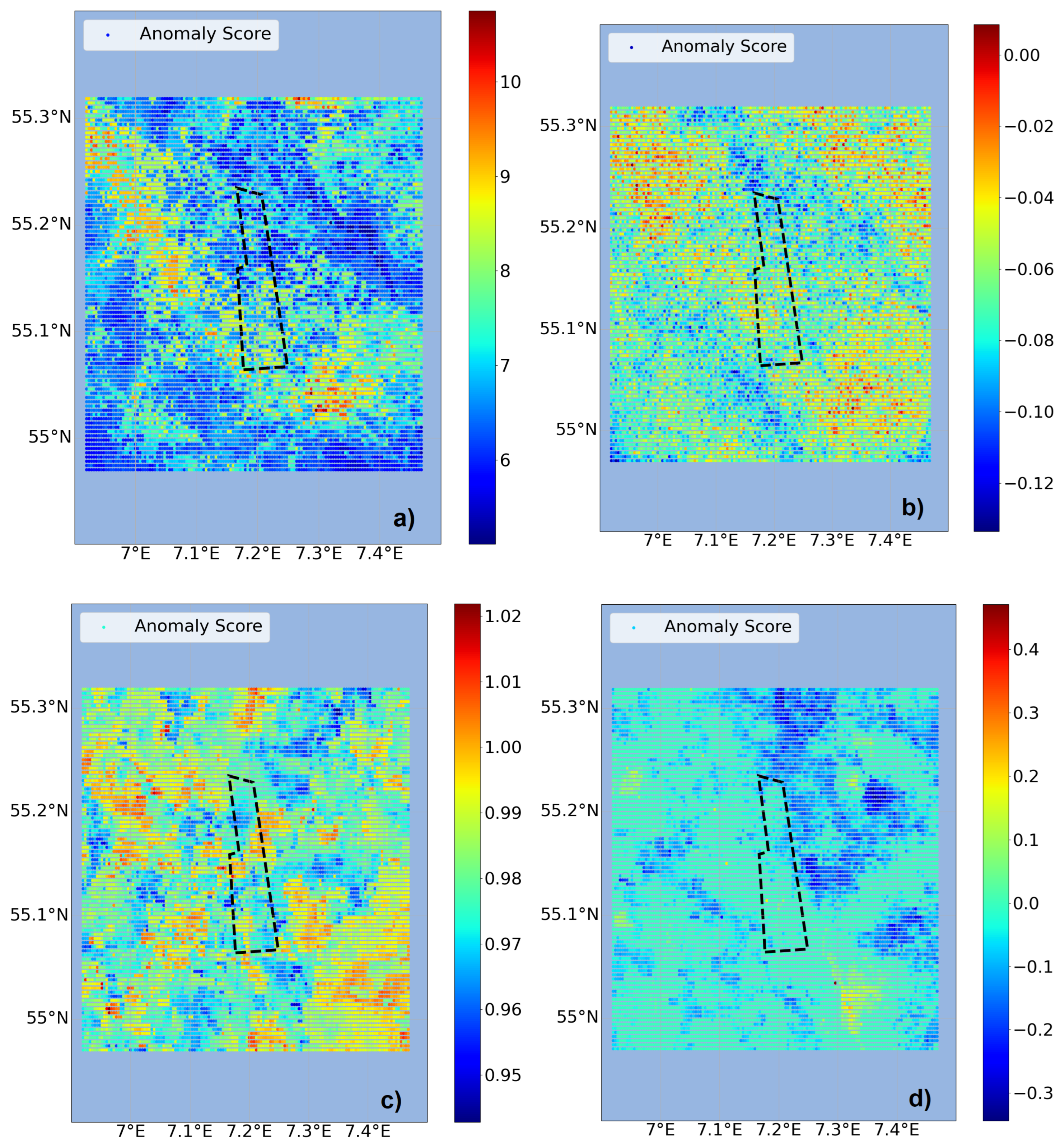





| Sentinel-3 | BSH-HBMnoku | FINO3 | |
|---|---|---|---|
| Type | Satellite | Model | In situ |
| Variable | Sea surface temperature Total suspended matter Chlorophyll | Temperature Salinity Current velocity Current direction | Wind speed Wind direction |
| Spatial resolution | 300 m–1 km | 900 m | Point measurement |
| Temporal resolution | 1 d | 15 min–1 h | 10 min |
Disclaimer/Publisher’s Note: The statements, opinions and data contained in all publications are solely those of the individual author(s) and contributor(s) and not of MDPI and/or the editor(s). MDPI and/or the editor(s) disclaim responsibility for any injury to people or property resulting from any ideas, methods, instructions or products referred to in the content. |
© 2023 by the authors. Licensee MDPI, Basel, Switzerland. This article is an open access article distributed under the terms and conditions of the Creative Commons Attribution (CC BY) license (https://creativecommons.org/licenses/by/4.0/).
Share and Cite
Schneider, J.; Klüner, A.; Zielinski, O. Towards Digital Twins of the Oceans: The Potential of Machine Learning for Monitoring the Impacts of Offshore Wind Farms on Marine Environments. Sensors 2023, 23, 4581. https://doi.org/10.3390/s23104581
Schneider J, Klüner A, Zielinski O. Towards Digital Twins of the Oceans: The Potential of Machine Learning for Monitoring the Impacts of Offshore Wind Farms on Marine Environments. Sensors. 2023; 23(10):4581. https://doi.org/10.3390/s23104581
Chicago/Turabian StyleSchneider, Janina, André Klüner, and Oliver Zielinski. 2023. "Towards Digital Twins of the Oceans: The Potential of Machine Learning for Monitoring the Impacts of Offshore Wind Farms on Marine Environments" Sensors 23, no. 10: 4581. https://doi.org/10.3390/s23104581
APA StyleSchneider, J., Klüner, A., & Zielinski, O. (2023). Towards Digital Twins of the Oceans: The Potential of Machine Learning for Monitoring the Impacts of Offshore Wind Farms on Marine Environments. Sensors, 23(10), 4581. https://doi.org/10.3390/s23104581






